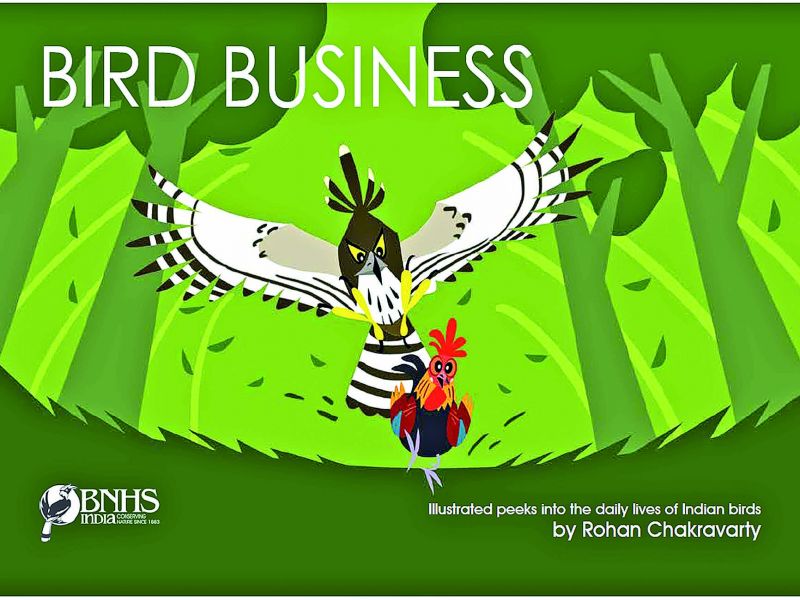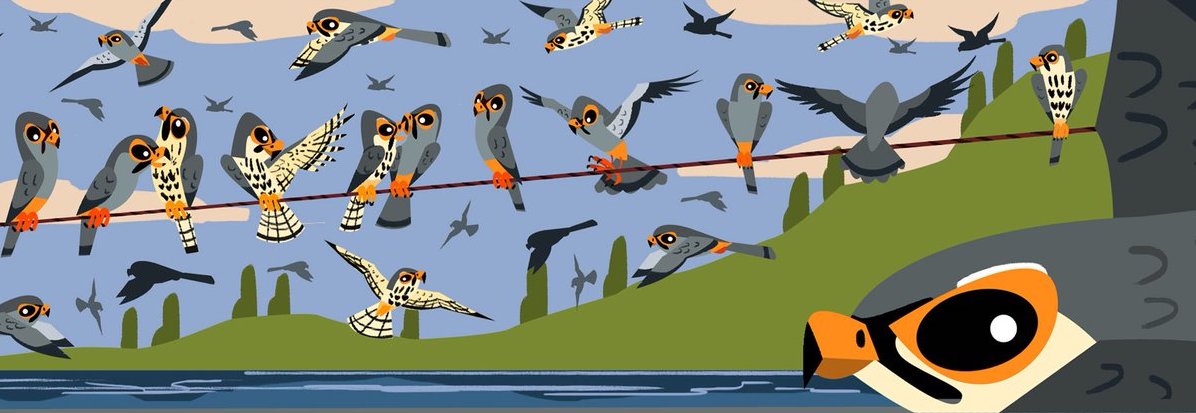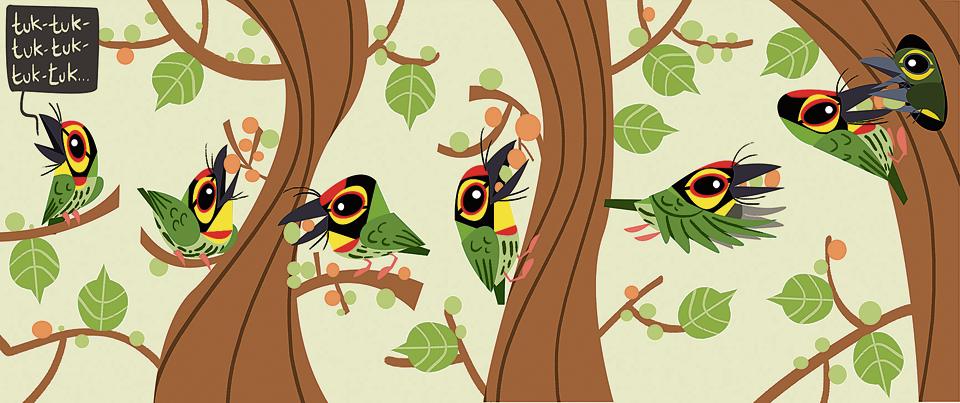BOOK REVIEW: Bird Business
Author: Rohan Chakravarthy
Publisher: BNHS

Birds being birds, as they flit from branch to branch to tree to sky it is tough to pin them down or catch on lens their daily chores. That’s where birder Rohan Chakravarthy’s book Bird Business comes in handy. Combining information on the wooing, nesting and feeding ways of birds with colourful sketches, he prepares a witty and engaging journey through the lives of a 100-odd birds found on the sub-continent. The eye-catching images and the humorous language make for happy reading.
No encyclopaedia on birds, this book published by Bombay Natural History Society is a good sampler for anyone who loves birds and is curious to know more, both for the experienced and the uninitiated. Written in simple language, this one is for all ages. Rohan weaves in info that can make the reader gape in wonder and shock, or smile fondly. This quick flyby past bird lives can even cause the fainthearted to miss a beat.
You have the gentle ones that mind their lives and fly by, harming not more than a fly or worm. At the other end of the spectrum there are the deadly ‘killers’ who ‘shred’ or ‘behead’ or rattle the bones of their prey on rock. It is all about survival. From loners to gregarious socialites to flamboyant show-offs, from shy secretive kinds to loud, threatening and boisterous kinds, the bird world has its mix. In this book, one gets a good idea of the diversity. Again, while a majority do the ‘morning shift’ there are those like the Indian night jar who have a ‘buzzing nightlife’ and ‘turn into a leaf or twig’ during the day.
Fun and fidelity
A large section of ‘bird-dom’ has its denizens conforming to gender roles and human notions of fidelity, but there are the deviations like the pheasant-tailed jacana mother or the painted snipe who can’t wait to go dating and leave their chicks in the care of dad. On the other hand there are birds like the peacock that struts away nonchalantly, leaving it all to the female of the species.
The millions of years of evolution notwithstanding, as birds evolved from theropod dinosaurs and their bodies got fine-tuned for flight, some birds still retain the reptilian memory. One wonders so, on reading about the common hoopoe, which when faced with a predator hisses like a snake, or the Eurasian wryneck that mimics a snake and twists from side to side to baffle its predator, or the oriental darter which ‘turns’ a serpent under water!
Rohan packs the diverse info in this page-turner where he touches upon the antics of a 100 of the 1000 or so bird species seen in India. The bright and vivid illustrations complete the picture, affording a slow-motion leap of the lesser florican here and a parabolic glide of the sparrow lark there.

The laborious ways of the streak-throated swallow as it builds its funnel shaped nests; the endearing red-wattled lapwing that courts death to lure predators away from its nest; the bill to bill courtship kiss of plum-headed parakeets; the fierce hoopoe chicks with a powerful weapon against intruders; the strange case of the rufous woodpecker that feeds on stinging acrobat ants and also builds its nest inside the ant colonies, with the ants for some reason overlooking the travesty; and so on, the book carries one into the mysterious lives of these flying dinosaurs.
Those seeking to enhance their GK quotient can learn about the world’s tallest flying bird that is a ballet dancer too, what the murmurs of the rosy starlings are about, meet the most adaptable bird many of us get to hear and see in the cities today, among many others. Rohan introduces the reader to the patient heron, the garbage scavenging greater adjutant, the wave-walking storm petrel, the dust bath of the sparrows, etc.
He does all this employing his brand of quick wit which most readers who follow Green Humour are familiar with. The allegories too are witty and in popular terminology, as can be witnessed in the headers on each page that talk of Cliffhangers and Pirates, Flashmobs and Good Shepherds. (The writing style brings to mind the works of popular non-fiction writer Bill Bryson whose latest book The Body is out there with all the tidbits of ‘inside’ information packaged in a tongue-in-cheek manner.)
If all that is not incentive enough to take a trip outdoor, there is the study from University of Exeter which concluded that people who experience more birds in their daily lives have a better mental health. I can vouch for that from my window-side birding.

There is nothing as engrossing and trancelike as watching birds. It can invoke a range of emotions in the watcher – awe, anxiety, sheer joy, sorrow. When the spotted dove decided to reuse the same nest from where it had raised one chick last monsoon, my joy knew no bounds. Watching the laborious process of laying the egg, to discovering the same stolen the next day and the parents all confused, I decided that this was not for me. Till the tailor birds came to stitch up their cozy nest on a nearby plant. The chweeps and anxious rat-a-tat calls brought fresh joy to the peeping tom in me. But sadly, I couldn’t be on time for the first flight. The same family (maybe) came again and built their nest anew on the same plant. I found myself busier but managed to see the babies in action – three fluffy balls. What a riveting joy it was cannot be conveyed in words. Experience has no substitute.
But Bird Business expands one’s horizon to bring home the awe and intrigue around the lives of many more birds than can be seen from your window sill.
What could have made the book weightier would have been an inclusion of where each species is found and what challenges they face. This is mentioned in few cases. But considering what the author clearly mentions his intention as -- “a celebration of the diversity in bird behaviour”, (NOT bird species per se) and a glimpse at that, there is no doubt the book achieves that.
Reviewed by Jayalakshmi K
(The book is available on Amazon, but for those willing to wait the third edition will be out very soon. You can also order copies by calling 022 22025481, 022 22015482, or email cmd@bnhs.org)